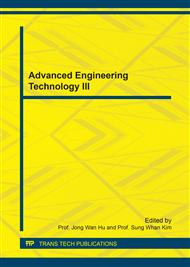p.137
p.143
p.149
p.155
p.161
p.169
p.175
p.181
p.188
A H2O2 Based Bio-Mimetic Power System Suitable for Jet Pack
Abstract:
This paper describes a pneumatically powered system based on hydrogen peroxide (H2O2) decomposition designed to provide enhanced energy and power density for wearable robotic applications. As one of the energy material, hydrogen peroxide shows good potentials for some applications like jet packs. In particular, the authors establish the pressurization system based on high frequency switch valves which involves a periodic pulsed gas explosion as a result of inspiration from the bombardier beetle. Then numerical simulations of spray force produced by the H2O2 based power system are presented. And the power system is used in movement enhanced jet pack in the end. The results show that spray force of the pulsed power system is directly proportional to the flow rate of H2O2, while inversely proportional to the volume of catalyst pack. At last the relationship between power system parameters and spray performances are discussed in detail.
Info:
Periodical:
Pages:
161-168
Citation:
Online since:
June 2017
Authors:
Price:
Сopyright:
© 2017 Trans Tech Publications Ltd. All Rights Reserved
Share:
Citation:


